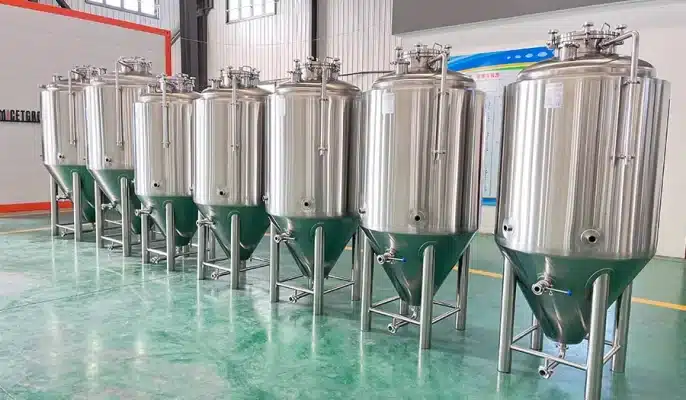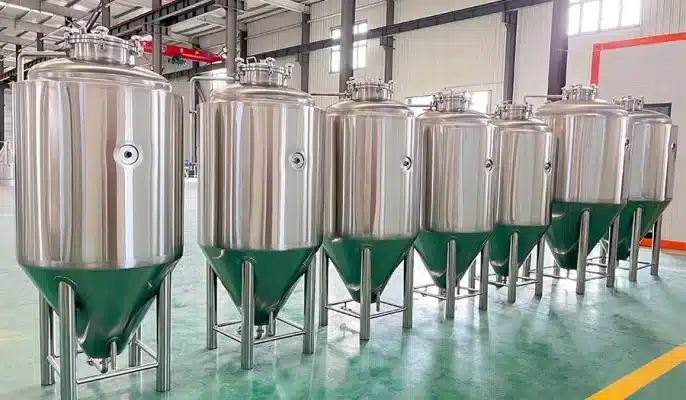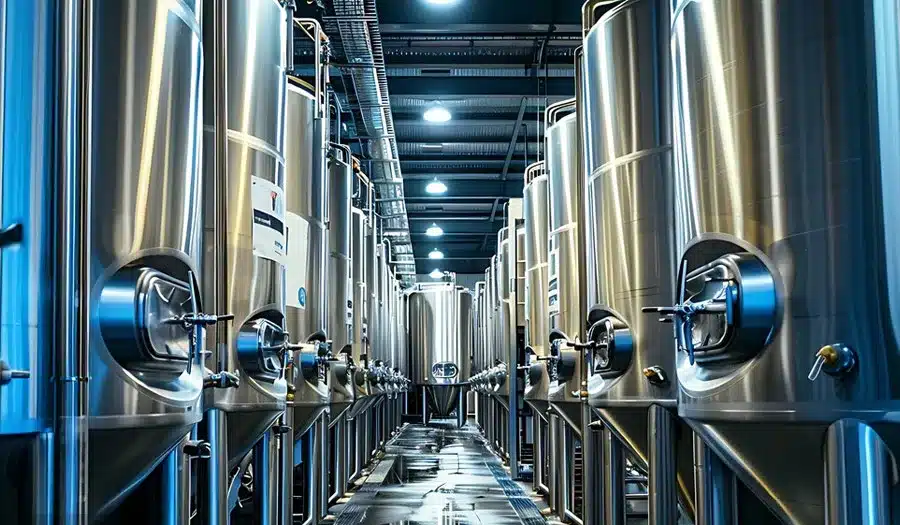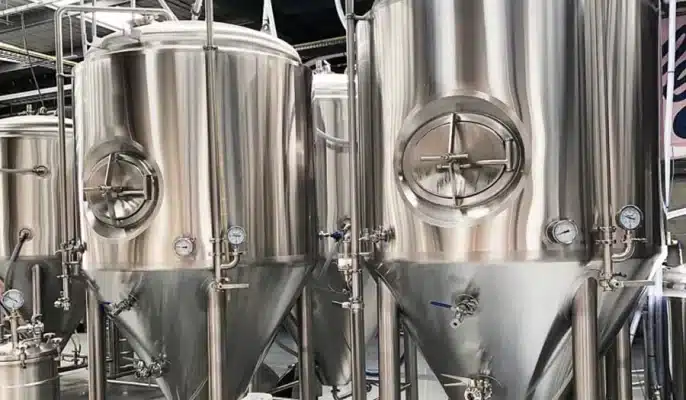O custo de um tanque de fermentação de cerveja é uma parte importante do processo de fabrico de cerveja, afectando diretamente a eficiência da produção e os benefícios económicos. Com o aumento da produção caseira e comercial de cerveja, surgiu no mercado uma variedade de tipos de tanques de fermentação, adequados a utilizadores de diferentes tamanhos e necessidades. Desde as cubas de fermentação utilizadas em pequenos laboratórios até às cubas de fermentação industriais de grandes dimensões, a diferença de preço é grande, sendo normalmente afetada por factores como a capacidade, os materiais, a marca e as funções adicionais.
O que é um fermentador?
Um fermentador é um dispositivo utilizado especificamente para a fermentação microbiana e é amplamente utilizado nas indústrias alimentar, de bebidas e farmacêutica. Proporciona um espaço confinado com condições ambientais controladas, tais como temperatura, pH, oxigénio e nutrientes, para promover o crescimento e o metabolismo dos microrganismos. Os fermentadores estão normalmente equipados com sistemas de agitação, sistemas de controlo de temperatura e dispositivos de controlo de gás para garantir a eficiência e estabilidade do processo de fermentação. Dependendo da aplicação, existem muitos fermentadores, desde pequenos equipamentos no laboratório até enormes tanques para produção industrial em grande escala.
Tipos de Fermentadores
Fermentadores abertos
Trata-se de um fermentador tradicional em que a superfície do líquido em fermentação fica exposta ao ar. Historicamente, muitas cervejeiras têm utilizado fermentadores abertos porque acreditam que proporcionam um melhor sabor, especialmente para certos tipos de cerveja, como as lambics belgas.
Fermentadores fechados
Estes fermentadores são completamente selados, proporcionando um ambiente mais controlado. São populares em muitas instalações modernas de fabrico de cerveja e vinho porque são eficazes na manutenção do saneamento e no controlo do processo de fermentação.
Fermentadores cónicos
Os fermentadores cónicos, favoritos dos fabricantes de cerveja caseiros e comerciais, têm uma forma que permite que a levedura e os sedimentos se depositem no fundo, facilitando a separação dos líquidos dos sólidos.
Tanques unitários
Os Unitanks são tanques versáteis que tratam tanto da fermentação como da carbonatação no mesmo recipiente. Podem ser mais económicos para alguns fabricantes de cerveja porque reduzem a necessidade de várias cubas.
Material do tanque de fermentação
O material do tanque de fermentação afecta diretamente o seu desempenho, a sua durabilidade e a dificuldade de limpeza e manutenção.
Os materiais mais comuns incluem:
- Aço inoxidável: As cubas de fermentação em aço inoxidável são muito utilizadas na indústria e nos laboratórios devido à sua resistência à corrosão e facilidade de limpeza.
- Vidro: Adequado para pequenas fermentações laboratoriais e fácil de observar o processo de fermentação, mas não adequado para produção em grande escala.
- Material polimérico: Leve, de baixo custo, adequado para determinadas aplicações específicas, mas pouco resistente a altas temperaturas e à corrosão química.
|
Material |
Características |
Ocasiões aplicáveis |
|
Aço inoxidável |
Resistente à corrosão, fácil de limpar |
Indústria, laboratório |
|
Vidro |
Fácil de observar |
Pequeno laboratório |
|
Materiais poliméricos |
Leve, de baixo custo |
Aplicações específicas |
Caraterísticas do Fermentador
Ambiente controlado
Os fermentadores proporcionam um ambiente selado que protege o produto fermentado de contaminantes externos, tais como leveduras selvagens, bactérias e partículas transportadas pelo ar, assegurando a pureza do processo de fermentação.
Regulação da temperatura
Muitos fermentadores, especialmente os fermentadores fechados, vêm com sistemas de controlo de temperatura. Manter a temperatura correta é fundamental porque afecta o metabolismo das leveduras e a dinâmica geral da fermentação, afectando em última análise o sabor e a qualidade do produto final.
Agitação e mistura
Alguns fermentadores têm agitadores incorporados. Uma mistura adequada assegura uma fermentação uniforme e um melhor controlo da temperatura, e pode melhorar a saúde da levedura, especialmente em fermentadores de grande volume.
Separação de sedimentos
Os tanques especialmente concebidos, como os fermentadores cónicos, permitem que a levedura e outros sedimentos se depositem naturalmente no fundo. Esta conceção simplifica o processo de limpeza e torna mais eficientes as fases subsequentes de filtração ou decantação.
Carbonatação
Alguns fermentadores, especialmente os fermentadores de tanque único, podem lidar com o processo de carbonatação. Uma vez concluída a fermentação, a bebida pode ser carbonatada diretamente no mesmo tanque sem ser transferida para outro recipiente.

Qual é o custo de um fermentador?
O preço de um fermentador pode variar muito em função do seu tamanho, material, função e fabricante. Desde os cervejeiros amadores até à produção industrial em grande escala, o preço de um fermentador varia muito.
- Tipo e capacidade: O custo dos fermentadores pequenos, médios e grandes varia muito. Os pequenos fermentadores são geralmente mais baratos, enquanto os grandes fermentadores industriais são caros. Quanto maior for a capacidade, mais elevados são os custos de material e de fabrico.
- Diferentes materiais: Normalmente utilizado em fermentadores industriais, é popular pela sua resistência à corrosão e facilidade de limpeza, e o seu custo é mais elevado. Utilizado em fermentadores de laboratório, o preço é relativamente baixo, mas não é tão durável e estável como o aço inoxidável.
- Função de conceção: Os fermentadores topo de gama estão normalmente equipados com controlo automático da temperatura, agitação, sistemas de monitorização em linha, etc., o que aumenta o custo global do equipamento. A adição de funções como a troca de gases e a antiespuma também aumentará o preço do equipamento.
- Marca e fabricante: O equipamento de marcas conhecidas tende a ser mais caro, mas oferece melhor qualidade e serviço pós-venda. A escolha de um fabricante de renome pode implicar custos mais elevados, mas um equipamento mais fiável.
- Transporte e instalação: Os custos de transporte de fermentadores de grandes dimensões são normalmente mais elevados, especialmente quando o transporte é efectuado entre regiões ou a nível internacional. A instalação profissional e a colocação em funcionamento podem exigir taxas adicionais, especialmente no caso de equipamento complexo.
- Custos de manutenção e funcionamento: O equipamento topo de gama pode exigir manutenção e inspecções regulares, o que aumentará os custos de funcionamento a longo prazo. A operação e a manutenção do equipamento requerem profissionais, e a formação e os salários do pessoal também fazem parte do custo.
- Procura do mercado: As alterações na procura de cerveja no mercado podem afetar o preço das cubas de fermentação, e a relação entre a oferta e a procura afecta diretamente o custo do equipamento.
Tabela de preços:
|
TAMANHO/CAPACIDADE |
MATERIAL |
PREÇO MÉDIO (USD) |
|
5 galões |
Vidro |
$50 - $100 |
|
5 galões |
Aço inoxidável |
$150 - $300 |
|
50 galões |
Plástico |
$300 - $500 |
|
50 galões |
Aço inoxidável |
$1,000 - $2,500 |
|
500 galões |
Aço inoxidável |
$5,000 - $10,000 |
|
Mais de 1.000 galões |
Aço inoxidável |
$10.000 e superior |
Aplicações dos Fermentadores
Vinificação
A aplicação mais conhecida dos fermentadores é na indústria vinícola. As fábricas de cerveja utilizam estes fermentadores para fermentar o mosto (o líquido extraído do processo de brassagem) em cerveja. O ambiente controlado assegura que a cerveja fabricada é de qualidade consistente.
Vinificação
À semelhança do processo de vinificação, os fabricantes de cerveja utilizam fermentadores para transformar o sumo de uva (ou mosto) em vinho. Embora alguns cervejeiros prefiram utilizar fermentadores abertos para introduzir leveduras selvagens, muitas cervejeiras modernas utilizam fermentadores fechados para controlar rigorosamente o processo.
Indústria dos lacticínios
Na indústria dos lacticínios, os fermentadores desempenham um papel fundamental na produção de iogurte, kefir e certos queijos. O processo de fermentação ajuda a quebrar a lactose e introduz bactérias benéficas, o que melhora o sabor e o valor nutricional do produto.
Processamento de alimentos
Para além das bebidas e dos produtos lácteos, os fermentadores também desempenham um papel importante na produção de vários alimentos fermentados, tais como kimchi, chucrute e pickles. Estes alimentos beneficiam da fermentação em termos de sabor e conservação.
Destilação
Para bebidas espirituosas como o uísque, o rum ou o brandy, os fermentadores são o primeiro passo. Uma vez concluída a fermentação, o líquido é transferido para uma unidade de destilação para aumentar a concentração de álcool.
Bebidas não alcoólicas
Muitas bebidas não alcoólicas populares, como a kombucha e certas bebidas probióticas, requerem fermentação. A kombucha, por exemplo, é feita através da fermentação de chá adoçado com uma cultura simbiótica de bactérias e leveduras, vulgarmente conhecida como SCOBY. O processo de fermentação dá a estas bebidas o seu sabor único, as bolhas e os alegados benefícios para a saúde.

Factores a considerar na escolha de um fermentador
- Requisitos de capacidade: Determinar o volume de fermentação necessário para selecionar a capacidade adequada. Cervejarias de diferentes tamanhos requerem fermentadores de diferentes tamanhos.
- Tipo e aplicação: Selecionar o tipo de fermentador com base na aplicação específica, como laboratório, fermentadores pequenos ou grandes, ou fermentadores sólidos ou líquidos para produtos específicos.
- Material: Escolha materiais resistentes à corrosão e fáceis de limpar (como o aço inoxidável) para garantir a qualidade do produto e prolongar a sua vida útil.
- Sistema de automação e controlo: Considerar o grau de automatização do fermentador e se são necessárias funções de controlo da temperatura, agitação e monitorização em linha para melhorar a eficiência operacional.
- Orçamento: Considerar o custo do equipamento com base no orçamento de capital, incluindo os custos de aquisição, transporte e instalação.
- Controlo da temperatura: A manutenção de uma temperatura exacta é essencial para muitos produtos fermentáveis. Os sistemas integrados de controlo da temperatura podem satisfazer esses requisitos.
- Marca e fabricante: Escolha uma marca bem conhecida ou um fabricante de renome para obter produtos mais fiáveis e um excelente serviço pós-venda.





